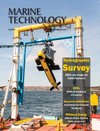
Page 49: of Marine Technology Magazine (June 2019)
Hydrographic Survey: Single & Multibeam Sonar
Read this page in Pdf, Flash or Html5 edition of June 2019 Marine Technology Magazine
“Continuous on-site monitoring of these activities is essential. But, Just now, (sample) analysis has to be done in a laboratory onshore. This means a delay in sampling and it’s impossible to do continuous monitoring. We looked at the lab-on-a-chip (micro? uidic analysis) and how to embed this into the payload of a submarine drone so that it can monitor large areas of interest and provide results in a continuous way and in real-time.”
Monica Periolatto, Polytechnic of Turin device such as an AUV, says Periolatto. They also need en- allow for mapping containment plumes or establishing a cor- ergy sources and pre-treatment of the samples for analysis. relation between contaminants and a source. “A more re? ned
The most common method for chromium detection in water environmental monitoring system” is needed, that can per- samples close to oil and gas facilities is diphenycarbazide form real-time mapping of water quality near offshore plat- (DFC) absorption. DFC involves a reaction which creates a forms using AUVs, Periolatto says. color detectable using a UV-visible spectrophotometer. The group from the SEADOG Lab and CNR-IMEM chose
But, today, this is done periodically, samples analyzed in to adapt the DFC absorption technique for use with micro- laboratories and the discrete nature of the sampling doesn’t ? uidic technologies (eg. lab-on-a-chip), to manage samples
The Seastick 300 AUV, from Gabri, of Genoa, loaded with SEADOG’s lab on a chip.
Photos from Polytechnic of Turin.
www.marinetechnologynews.com
Marine Technology Reporter 49
MTR #5 (34-49).indd 49 5/24/2019 11:04:21 AM

 48
48

 50
50
